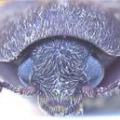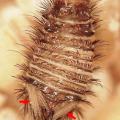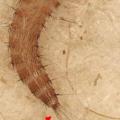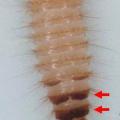Dermestidae family
Who are they ?
The species that belong to that family are medium-sized to small (less than 11 mm). They are usually dark-coloured, although their thorax and their elytra often have more or less brightly coloured tufts of hair or rows of bristles or scales on the top.
Main morphological characteristics and faunistic data
Most Dermestidae species have antennae with a compact, distinct club at their end. Club shape can vary and can make it possible to characterise genera and certain species, and even sex in some cases.
Examples of characteristic antennae of the main Dermestidae genera.







Dermestes Dermestes Attagenus unicolor Anthrenus Anthrenus Trogoderma
Pruvianus frischi (Mâle et femelle) pimpinellae Verbasci versicolor
Hind coxae are transverse and excavated. Femurs are lodged in the excavations at rest, which is not the case in Bostrichidae; besides, hind hips are close to each other (almost contiguous) and dilated into a narrow lamella in their top part. Tarsa are pentameric, i.e. they all have 5 articles. Most of the species that belong to that family belong to the Anthrenus, Attagenus and Dermestes genera. Species belonging to those 3 genera are also those most often found in museum institutions. The Anthrenus gender is easily distinguishable from the other two as adults have a scaly body. Attagenus et Anthrenus genera have an ocellus inserted in the middle of their forehead. Such an ocellus is absent in all other Dermestes species.
Habitus of the 3 main Dermestidae genera found in heritage sites



Genre Attagenus Genre Anthrenus Genre Dermestes
Attagenus unicolor Anthrenus Verbasci Dermestes Undulatus
Detail of the ocellus found in Anthrenus genus (arrow), but not found in the Dermestes genus.


Anthrenus Verbasci Dermestes peruvianus
Among the species of that family, Thylodrias contractus (cf. fact-sheet) radically differs from the other genera and species due to its particular morphology. Indeed, male adults have filiform antennae without a club at their end, a long body and frail legs, whereas females are wingless, stocky, and look more like larvae. The larvae of most Dermestidae species have tufts of bristles at the end of their abdomen (long and simple in Attagenus, lanceolate in Anthrenus), or hooks (urogomphs) in Dermestes. Another characteristics of that family is that larval exoskeletons (exuvia) remain whole and intact after molting, so that species identification can usually be performed from those remains, which are often found in or on infested materials.
Habitus of a few Dermestidae larvae found in heritage sites.




Anthrenus Sefrania Dermestes Trogoderma
species bleusei species species
